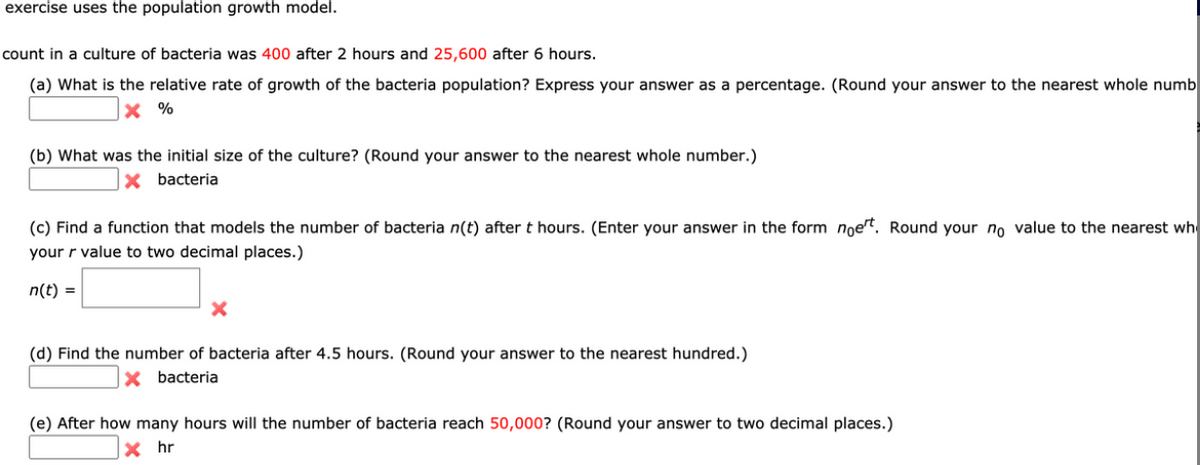exercise uses the population growth model. count in a culture of bacteria was 400 after 2 hours and 25,600 after 6 hours. (a) What is the relative rate of growth of the bacteria population? Express your answer as a percentage. (Round your answer to the nearest whole numb X % (b) What was the initial size of the culture? (Round your answer to the nearest whole number.) X bacteria (c) Find a function that models the number of bacteria n(t) after t hours. (Enter your answer in the form noet. Round your no value to the nearest wh your r value to two decimal places.) n(t) = (d) Find the number of bacteria after 4.5 hours. (Round your answer to the nearest hundred.) X bacteria (e) After how many hours will the number of bacteria reach 50,000? (Round your answer to two decimal places.) X hr
exercise uses the population growth model. count in a culture of bacteria was 400 after 2 hours and 25,600 after 6 hours. (a) What is the relative rate of growth of the bacteria population? Express your answer as a percentage. (Round your answer to the nearest whole numb X % (b) What was the initial size of the culture? (Round your answer to the nearest whole number.) X bacteria (c) Find a function that models the number of bacteria n(t) after t hours. (Enter your answer in the form noet. Round your no value to the nearest wh your r value to two decimal places.) n(t) = (d) Find the number of bacteria after 4.5 hours. (Round your answer to the nearest hundred.) X bacteria (e) After how many hours will the number of bacteria reach 50,000? (Round your answer to two decimal places.) X hr
College Algebra
7th Edition
ISBN:9781305115545
Author:James Stewart, Lothar Redlin, Saleem Watson
Publisher:James Stewart, Lothar Redlin, Saleem Watson
Chapter4: Exponential And Logarithmic Functions
Section4.6: Modeling With Exponential Functions
Problem 14E
Related questions
Question

Transcribed Image Text:exercise uses the population growth model.
count in a culture of bacteria was 400 after 2 hours and 25,600 after 6 hours.
(a) What is the relative rate of growth of the bacteria population? Express your answer as a percentage. (Round your answer to the nearest whole numb
X %
(b) What was the initial size of the culture? (Round your answer to the nearest whole number.)
X bacteria
(c) Find a function that models the number of bacteria n(t) after t hours. (Enter your answer in the form noet. Round your no value to the nearest wh
your r value to two decimal places.)
n(t) =
(d) Find the number of bacteria after 4.5 hours. (Round your answer to the nearest hundred.)
X bacteria
(e) After how many hours will the number of bacteria reach 50,000? (Round your answer to two decimal places.)
X hr
Expert Solution
This question has been solved!
Explore an expertly crafted, step-by-step solution for a thorough understanding of key concepts.
This is a popular solution!
Trending now
This is a popular solution!
Step by step
Solved in 4 steps

Recommended textbooks for you

College Algebra
Algebra
ISBN:
9781305115545
Author:
James Stewart, Lothar Redlin, Saleem Watson
Publisher:
Cengage Learning

Glencoe Algebra 1, Student Edition, 9780079039897…
Algebra
ISBN:
9780079039897
Author:
Carter
Publisher:
McGraw Hill

Algebra and Trigonometry (MindTap Course List)
Algebra
ISBN:
9781305071742
Author:
James Stewart, Lothar Redlin, Saleem Watson
Publisher:
Cengage Learning

College Algebra
Algebra
ISBN:
9781305115545
Author:
James Stewart, Lothar Redlin, Saleem Watson
Publisher:
Cengage Learning

Glencoe Algebra 1, Student Edition, 9780079039897…
Algebra
ISBN:
9780079039897
Author:
Carter
Publisher:
McGraw Hill

Algebra and Trigonometry (MindTap Course List)
Algebra
ISBN:
9781305071742
Author:
James Stewart, Lothar Redlin, Saleem Watson
Publisher:
Cengage Learning

Big Ideas Math A Bridge To Success Algebra 1: Stu…
Algebra
ISBN:
9781680331141
Author:
HOUGHTON MIFFLIN HARCOURT
Publisher:
Houghton Mifflin Harcourt


Algebra & Trigonometry with Analytic Geometry
Algebra
ISBN:
9781133382119
Author:
Swokowski
Publisher:
Cengage